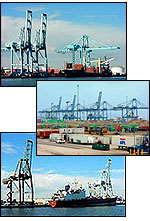Water: Vessel Water Discharge
EPA and the Committee on the Marine Transportation System
| Oceans, Coasts, Estuaries & Beaches Quick Finder | |||
|---|---|---|---|
| Oceans, Coasts, & Estuaries Home Coastal Watershed Protection | Marine Pollution Prevention Monitoring and Assessment | Ocean & Coastal Partnerships Frequently Asked Questions | Coasts for Kids |
Features
National Strategy for the Marine Transportation System: A Framework for Action | PDF Version (61 pp, 1.2MB, About PDF)

Photograph Descriptions:
Top: Port of Jacksonville, Fla., portside loader and freighter at the dock.
Middle: Dundalk, Md., trucks, train tracks and loaders in the harbor.
Bottom: Crane loaders at Port of Jacksonville, Fla.
Ports and harbors are valuable links to domestic and international commerce and opportunity for recreation. We all use marine transportation to receive imports and ship out exports. Ports are home to recreational and commercial fishing fleets, as well as small boats, ferries and cruise ships.
Ports may be found along on our ocean coasts, the Gulf of Mexico, Great Lakes, and U.S. inland waterways. Because they are often sited in sensitive coastal and inland aquatic areas, America's ports and harbors play a vital role in protecting our valuable resources.
EPA and its partners have been working on several projects to examine and explain the impact of shipping, port locations and waste management, among other issues related to the marine transportation industry.
Dredged Material Management
EPA's Dredged Material Management Program supports environmentally responsible dredged material planning and management. Dredged material management includes development of environmental criteria, review of draft permits, testing dredged material to be disposed, consideration of alternatives to dredging and disposal options, site designations, and encouraging beneficial uses of dredged material.
Invasive Species and Ballast Water
One of the greatest threats to U.S. waters and ecosystems is caused by the uncontrolled spread of invasive species. Both terrestrial and aquatic invasive species can be harmful to our waters - some affect the water directly, while other species affect the land in ways that harm the water. Ballast water can contain living organisms taken up in a port half-way around the world, which can invade the area where the water is discharged.
Cruise Ship Water Discharges
EPA is assessing waste water discharges from cruise ships and reviewing regulatory options for control.
Uniform National Discharge Standards (UNDS) For Armed Forces Vessels
![]()
UNDS requires EPA and the Department of Defense to jointly establish uniform standards nationwide for discharges incidental to the normal operation of armed forces vessels.
EPA participates in the Committee on Marine Transportation System ![]() on environmental issues such as dredging and ship channel configuration, reducing pollutant sources during operations and cargo handling. EPA also works on ballast waster management to reduce invasions of non-indigenous species, and the management of discharges from cruise ships, armed forces, and recreational vessels.
on environmental issues such as dredging and ship channel configuration, reducing pollutant sources during operations and cargo handling. EPA also works on ballast waster management to reduce invasions of non-indigenous species, and the management of discharges from cruise ships, armed forces, and recreational vessels.
